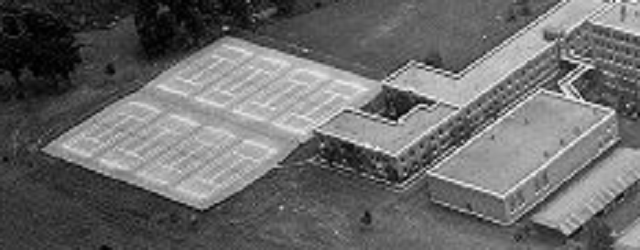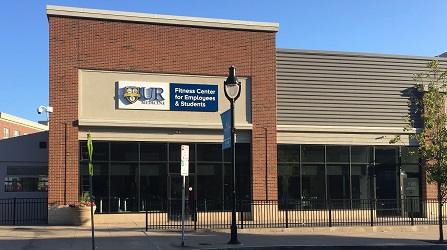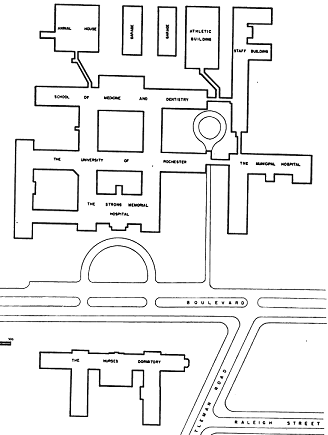

| Medical Center | Athletic Center |
 |
 |
| Athletic Center and Tennis Courts about 1935 | New Fitness Center in College Town (July 2022) |
 |
| Plot Plan from Hospital
Planning, by Charles Butler and Addison Erdman (1946) Page 118 |
Opportunities for athletic activities were initially met with impromptu handbook courts along with tennis courts and a softball fields build in adjacent open areas. Medical school students, staff and faculty were allowed to use the Alumni Gymnasium on River Campus that opened in October 1930, but it was inconvenient, especially during the winter months.
At the urging of President Rush Rhees, the Trustees funding the construction of an Athletic Center adjacent to the Medical School that opened in November 1933 and was closed in 2020 to allow the space to accommodate growing patient care needs. A small Fitness Center reopened in the former gym space in early 2022 and will relocate to the former Bar 145 space at 71 Celebration Drive in College Town and open on July 28, 2022.
The building was demolished in 2023 to accommodate the Emergency Department Expansion and new Patient Care Tower project.
References
1933 "Medics
Open New Athletic Indoor Courts," Democrat and Chronicle,
November 2, 1933, Page 9.
Squash Rackets Play Features Program of Dedication.
1936 The
First Decade 1926-1936
Pages 91-92: The athletic impulses of our staff first found
expression in several impromptu handball courts which sprang up in various
unused rooms of the main building, and in the softball field which has
been the scene of many hard-fought games. In 1928-29 eight tennis courts
were constructed for staff and students and two for the nurses.
These facilities, however, provided no opportunities for exercise during
the winter, and arrangements to use the gymnasium of the College for Men
did not work out because of the distance. In 1933, therefore, the School
undertook the construction of an Athletics Building, which has been of the
greatest benefit to the health and spirits of the institution. The
building contains a basket ball court, four courts for squash and
handball, room for boxing, wrestling and table-tennis, with locker rooms
and shower baths.
1950 The
First Quarter Century 1925-1950
Page 16: A note about the Athletics Building may be of interest. As
a rule the facilities for exercise are inadequate in most schools and
hospitals, and this had been pointed out to President Rhees who was
sympathetic. When his son, Dr. Morgan Rhees, developed a
pneumothorax which at that time was thought to be due to tuberculosis, the
President and Trustees became personally concerned with recreation and
student health problems and in 1933 authorized the construction of this
building. It contains 4 squash and handball courts, a large room for
basketball, volleyball and badminton, locker and shower rooms. It ha
contributed much to the well-being and health of the hard-working staff
and students.
Pages 131-132: Athletics Building, by John A. Schilling
The desire of President Rhees and Dean Whipple to improve student health
was implemented by a grant from the trustees of the University for the
construction of a gymnasium (cf. page 16). The gymnasium was completed in
its present form in 1933 and Dr. Fenn became the first chairman of the
Athletic Committee. There was considerable competitive athletic rivalry
between the various members of the senior and junior staffs and students
at this period, as there is at present. The eight tennis courts were
constructed at this period and ample space was available for outdoor
baseball. The gymnasium when completed consisted of a large basketball
floor, four squash and handball courts, a storeroom, a barber shop, a
billiard room, and a large recreation room. There were three locker rooms:
one for the senior staff, one for the medical students, and a third for
the ladies. It was a major decision at that time, but in keeping with the
general spirit of the Medical School and Hospital, to allow women to
participate without segregation in the athletic activities.
Since then, the female members of the faculty and student body, wives of
members of the faculty and nurses have used the gymnasium whenever they
wished, on the same basis as the men.
In the early years, one day was set aside as athletic day during which
various members of the faculty and student body participated in
competitive games, both individually and as teams. In the evening there
were indoor athletic events and dancing, followed by refreshments. Dr.
Stafford Warren and Dr. Metildi were said to have violently engaged with
foils as part of one of these exhibition programs. Throughout the years
Lhe gymnasium has been used increasingly for social events such as staff
parties and hospital personnel parties, dances and other meetings of an
informal nature.
Subsequent chairmen of the Athletic Committee were Dr. Albert Snoke, Dr.
Basil Bibby, Dr. Harold Hodge, Dr. Victor Emmel, and Dr. John Schilling.
Through the efforts of these men the supervision and development of the
athletic and social programs continued.
Two student assistants, Robert Shanewise and Arthur Hall, at present are
appointed to take care of locker assignments and the towel service, and to
check out items of equipment. Their most important duty, however,
is to organize seasonal competition throughout the year, thus assuring
continuity of program. This includes touch football, basketball, squash,
baseball, and tennis. In past years, Paul Rekers, Quin Serenati, and Chris
Kalsampes have carried out these duties. In particular, the basketball and
baseball games are a source of keen competition and am of much interest to
the various classes and staff members.
In 1948, the large recreation room that originally existed was
divided. During the war years it had been used as a day nursery and
later as a storage space. The smaller portion was used for various types
of athletic exercising equipment and the larger south room was assigned to
the students for use as a nonathletic recreation room. From funds they
have raised by dances and co-operative efforts the students have furnished
this room and have used it for informal parties and small social
gatherings of an impromptu nature.
It was some time after the tennis courts were first built before anyone
discovered that they were 3 feet too short on both ends. When this was
corrected, the back-stops were too close by an equal distance.
The tennis courts were resurfaced with asphalt during the early war years,
thus reducing the burden of upkeep. The baseball diamond lost some of its
outfield and was shifted northerly with the advent of the large northwest
parking lot and the completion of the Psychiatric Clinic.
The members of the Psychiatric Staff now utilize the facilities of the
gymnasium in the off-hours for physical recreation of their patients.
Various groups within the medical family are assigned evenings in the
gymnasium for activities such as badminton, basketball, dancing and the
like.
It is felt that this increasing use of the gymnasium for athletic and
social purposes has exerted a unifying as well as healthful influence
which amply justifies the original expectations.
1975 To
each his farthest star: The University of Rochester Medical
Center -1925-1975, edited by Edward C. Atwater and John
Romano.
Page 60: In 1929 tennis courts were built near the Staff House, and
in 1933 the Medical School gymnasium was built. A majority of persons in
the School utilized the athletic facilities, and tournaments were annually
scheduled in squash, handball, and tennis.
1977 History
of the University of Rochester, 1850-1962, by Arthur J.
May. Expanded edition with notes
Chapter 28: Music and Medicine in the 1930's
In the meantime, additions had been made to the physical properties of the
Medical Center. A much appreciated athletics building, two stories high,
to the north of the Medical School, for basketball, squash, handball, and
wrestling was opened in the summer of 1933. It was also used for dances
and parties and soon the lounge was fitted up as a recreational
rendezvous.
Until the erection of the athletic building at the Medical Center,
students were privileged to make use of the facilities for physical
exercise on the River Campus. Student health created problems, especially
the high incidence of tuberculosis, an affliction that was almost
completely overcome after a Health Service was organized (1934).
2022 Fitness Center moves to College Town
© 2021 Morris A. Pierce